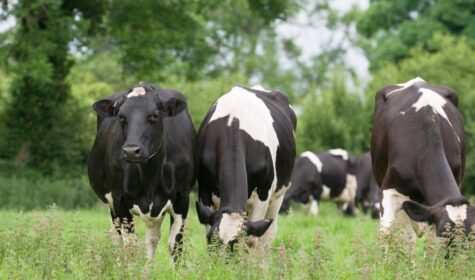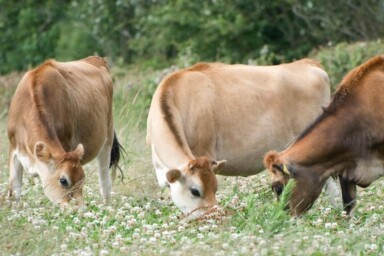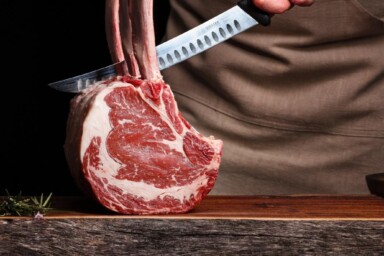Advertisers love to put images of grazing cows on dairy products. However, the animals you are mostly likely to see grazing in the British countryside are beef cattle.
For one, dairy cows need to be milked, and to get them into a milking parlour twice a day can be a lot easier when they are housed. And secondly, many dairy cows have been bred to produce such enormous amounts of milk that there are literally not enough hours in the day for them to take up sufficient nutrients through grazing. Farmers make up for that by giving them concentrated feed such as soybean meal, grains and maize which are rich in proteins and calories.
But cattle are ruminants and with their four stomachs and the many trillions of microorganisms in them, they can do what we can’t: convert grass into nutrition that sustains them. Concentrate feed upends this unique system; the microorganisms are ill suited to deal with soy and grains and therefore much less efficient in providing the cow with proteins. So, for health reasons alone, it would be good if the diet of dairy cows consisted of more grass and hay, and as little concentrate feed as possible.
Less is more
In a three-year study, scientists in Germany have shown that reducing the amount of concentrate fed to dairy cows has more than just health benefits. The 122 participating dairy farms fell into one of four groups: certified organic farms feeding either low or high amounts of concentrate feed and conventional farms with either low or high use of concentrate feed. The average herd size was 49 cows, the average milk yield per cow per year was a little over 6,000 kg.
The big surprise from the study was the economic data: dairy farms using little concentrate feed earned less from each cow, but their costs were so much lower that they had a healthier bottom line – over all they proved to be more economical. Buying feed concentrate is expensive, but growing soy, maize and grains as animal feed on farm, isn’t much cheaper either. There is the cost of seeds, and conventional farmers will have expenses for fertilisers and pesticides, and someone has to do the field work, so there are labour costs. While organic low concentrate farms mostly saved labour costs, conventional low concentrate farms spent almost 40% less on pesticides and 20% less on fertiliser. And, of course, there are measurable benefits for the environment when chemical inputs are substantially reduced.
Not all cows are equal
The study also shows that not all cows do well on a reduced concentrate feed diet. Of the successful farms, where animals did well on little or no concentrate feed, 80% kept regionally adapted dairy breeds, crossbreeds and dual use breeds such as Simmental. ‘For a low concentrate feed regime, it’s important that the dairy cows are long-lived, healthy and robust,’ writes Karin Jürgens (Unabhängige Bauernstimme, Oktober 2021), one of the authors of the study. The cows need to be able to graze well and be selective in order to make optimum use of the available feed, she says. ‘That’s why these farms use cross-breeds adapted to the system or animals bred on their farm.’ While Holsteins are the most common dairy breed, followed by Jerseys, the scientists found a high diversity of dairy breeds on the low concentrate feed farms, with 15 of the 21 dairy breeds registered in Germany represented. Just 15% of the low concentrate farms in the study kept only rare breeds.
Insufficient support
The success of the low concentrate system depends on how much milk the cows can produce from grass – which includes grazing permanent pastures, clover and lucerne (alfalfa) as well as feedings of hay. On conventional farms 72% of the milk came from grass, on organic farms it was 81%. To make sure the feed always provides sufficient energy and proteins, some grassland areas are farmed intensively (mowed three to four times a year) and others extensively. On low concentrate feed farms, 88% make hay for their dairy cows.
Low concentrate feed systems are an animal-friendly way to produce dairy while also reducing nitrogen leaching and soil erosion as well as increasing and maintaining biodiversity in grasslands, the study found. These farmers do valuable work for the environment, says Jürgens, but even though it is a profitable way to produce dairy, the overall farm income lies below the national average. One reason is that the number of cows will depend on the grassland available, which of course cannot be scaled up. Jürgens’ conclusion: the work these farmers do is not sufficiently supported.
Milk and methane
‘Cattle do not cause climate problems, energy intensive agriculture does, with monocultures for the production of concentrated feed, often fertilised with synthetic nitrate compounds’
says veterinarian Anita Idel in an EU study on climate change and agriculture in 2020.
But what about methane? It’s a potent greenhouse gas and as with carbon dioxide, there is way too much of it in the atmosphere. Unlike carbon dioxide, methane is short lived, but environmentalists often hold ‘burping cows’ responsible for a considerable part of the world’s methane emissions and make the case for a vegan lifestyle. A study at the research farm at Kiel University in Germany has shown that dairy cows on pasture can produce high milk yields without producing large amounts of methane. Cattle emit methane mostly (96%) through the mouth when they burp. To measure the methane emission, the animals were fitted with a head collar and a belt that kept the measuring device in place. Two groups of Jersey cows grazed either a mix of grasses and clover or a mix of eight species including herbs and legumes (and both groups also received a small amount of concentrate feed). Some of the plants were particularly rich in tannins because it was assumed that this would reduce the cows’ methane emissions. This wasn’t the case, but, compared to the international standard, methane emissions for both groups were extremely low and the milk yield was comparable to that of Jersey cows receiving a much higher ration of concentrate feed. The milk production of the Jerseys grazing the eight species mix made no difference to the methane emissions but increased the milk yield by 4%.
Grazing for the environment
In order to accurately compare methane emissions and milk yields, the scientists chose a clover/grass mix and an herbal ley because the nutritional value can be measured and controlled. On permanent pasture, many different species will establish themselves over time and they might not be as nutritious as clover. More research is needed, said the scientific coordinator, Carsten Malisch (Unabhängige Bauernstimme, Mai, 2021), but ‘with this study we were able to show that grazing based dairy production combines very high milk yields with very low methane emissions and can therefore contribute to climate protection – without having to import feed, because clover provides all the protein needed’. Or, as Anita Idel wrote in the EU study on climate change (p. 60), there is still a lot more to know about the beneficial interaction between grazing animals and grasslands: ‘Within the concept of climate change, the challenge and the chance lies in turning the focus on grassland and its potential. This is particularly true for its potential to build soil and the climate mitigation linked to it. In addition, there are the effects on the protection of soils and water bodies during prolonged periods of drought as well as during increased heavy rain events…Therefore, grassland and grazing management and their influence on biodiversity are absolutely key for the building of fertile soils.’





